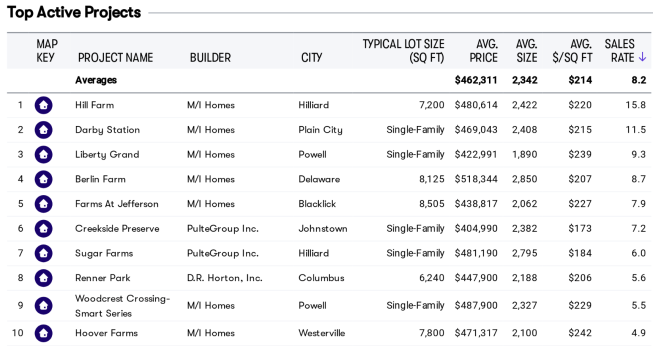Heading into spring, Columbus saw some month-over-month gains in new- and existing-home sales as local real estate agents observed plenty of demand from potential buyers.
Throughout early 2023, Realtor.com consistently ranked Columbus in the top five of its Hottest Housing Markets, based on views per property on its website and the number of days a listing remained active.
For new homes, Columbus’ average sales rate is down 20% compared with pre-pandemic 2019, and quick move-in inventory is 130% higher than 2019.
Builders, however, are in a good position to sell this inventory due to still-tight resale inventory, which is 54% below 2019 levels.

Strengths
Resiliency in housing demand stems from major employers like The Ohio State University, the state government, Nationwide Insurance, and JPMorgan Chase (the metro’s largest private employer). Columbus is also a magnet for tech jobs that generally attract younger residents.
Weaknesses
Columbus has become a bit more expensive relative to itself. The metro’s existing-home affordability ratio is much higher than its new-home affordability ratio. Due to higher interest rates, JPMorgan Chase recently cut some jobs in its mortgage business.
Sales
New-home sales in the Columbus area decreased 35% year over year to an annualized rate of 3,082 units in March. Existing-home closings for the 12-month period ending in April posted a year-over-year decline of 33.2% to an annualized rate of 31,679 units.
Prices
The average list price for a new detached home in Columbus increased 4.4% from 2022 to $458,220 in March, while the average list price for a new attached home decreased 22.1% over the same period to $370,833. Homes priced under $250,000 experienced the most closing activity over the past year.

Economy
TotaI non-farm employment in the Columbus metropolitan statistical area increased 0.8% from the same period last year to 1,146,000 payrolls in February. There were approximately 900 more jobs in February compared with the previous month. The local unemployment rate decreased to 3.5% in February compared with 3.6% in the previous month. February’s jobless rate is higher than it was this time last year when it stood at 3.3%. Zonda forecasts the region’s unemployment rate will finish the year at 2.9%.
Community
The current population for the state capital is approximately 2,210,650 people. Population in the area is projected to increase by 1.1% this year. Approximately 865,450 households reside in the region, up 0.8% year over year. Forecasts show that current household formation is expected to increase by an annual growth rate of 2% through 2027. Household income increased by 9.2% from the previous year to $82,054.
Did you know you can access free housing data with Zonda’s Market Snapshots? Reports include new-home supply and valuation, resale listings, jobs, market forecasts, and more. Get your complimentary market snapshot for your local CBSA today.



